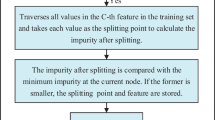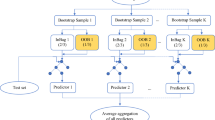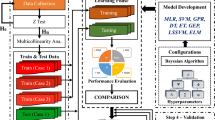Abstract
The behavior of rock masses is influenced by a variety of forces, with measurement of stress and strain playing the most critical roles in assessing deformation. The laboratory test for determining strain at each location within rock samples is expensive and difficult but rock strain data are important for predicting failure of rock material. Many researchers employ AI technology in order to solve these difficulties. AI algorithms such as gradient boosting machine (GBM), support vector regression (SVR), random forest (RF), and group method of data handling (GMDH) are used to efficiently estimate the strain at every point within a rock sample. Additionally, the ensemble unit (EnU) may be utilized to evaluate rock strain. In this study, 3000 experimental data are used for the purpose of prediction. The obtained strain values are then evaluated using various statistical parameters and compared to each other using EnU. Ranking analysis, stress-strain curve, Young’s modulus, Poisson’s ratio, actual vs. predicted curve, error matrix and the Akaike’s information criterion (AIC) values are used for comparing models. The GBM model achieved 98.16% and 99.98% prediction accuracy (in terms of values of R2) in the longitudinal and lateral dimensions, respectively, during the testing phase. The GBM model, based on the experimental data, has the potential to be a new option for engineers to use when assessing rock strain.
Similar content being viewed by others
References
Bruning T, Karakus M, Nguyen G D, Goodchild D. An experimental and theoretical stress—strain—damage correlation procedure for constitutive modelling of granite. International Journal of Rock Mechanics and Mining Sciences, 2019, 116: 1–12
Yu P, Pan P Z, Feng G, Wu Z, Zhao S. Physico-mechanical properties of granite after cyclic thermal shock. Journal of Rock Mechanics and Geotechnical Engineering, 2020, 12(4): 693–706
Zhang G, Gao F, Wang Z, Yue S, Deng S. Quantifying the progressive fracture damage of granite rocks by stress—strain, acoustic emission, and active ultrasonic methods. Journal of Materials in Civil Engineering, 2021, 33(12): 04021353
Zhao K, Yu X, Zhou Y, Wang Q, Wang J, Hao J. Energy evolution of brittle granite under different loading rates. International Journal of Rock Mechanics and Mining Sciences, 2020, 132: 104392
Duan K, Ji Y, Wu W, Kwok C Y. Unloading-induced failure of brittle rock and implications for excavation-induced strain burst. Tunnelling and Underground Space Technology, 2019, 84: 495–506
Goswami S, Anitescu C, Chakraborty S, Rabczuk T. Transfer learning enhanced physics informed neural network for phase-field modeling of fracture. Theoretical and Applied Fracture Mechanics, 2020, 106: 102447
Samaniego E, Anitescu C, Goswami S, Nguyen-Thanh V M, Guo H, Hamdia K, Zhuang X, Rabczuk T. An energy approach to the solution of partial differential equations in computational mechanics via machine learning: Concepts, implementation and applications. Computer Methods in Applied Mechanics and Engineering, 2020, 362: 112790
Nguyen-Thanh V M, Anitescu C, Alajlan N, Rabczuk T, Zhuang X. Parametric deep energy approach for elasticity accounting for strain gradient effects. Computer Methods in Applied Mechanics and Engineering, 2021, 386: 114096
Zhuang X, Guo H, Alajlan N, Zhu H, Rabczuk T. Deep autoencoder based energy method for the bending, vibration, and buckling analysis of Kirchhoff plates with transfer learning. European Journal of Mechanics. A, Solids, 2021, 87: 104225
Anitescu C, Atroshchenko E, Alajlan N, Rabczuk T. Artificial neural network methods for the solution of second order boundary value problems. Computers, Materials & Continua, 2019, 59(1): 345–359
Guo H, Zhuang X, Rabczuk T. A deep collocation method for the bending analysis of Kirchhoff plate. Computers, Materials & Continua, 2019, 59(2): 433–456
Bardhan A, Kardani N, GuhaRay A, Burman A, Samui P, Zhang Y. Hybrid ensemble soft computing approach for predicting penetration rate of tunnel boring machine in a rock environment. Journal of Rock Mechanics and Geotechnical Engineering, 2021, 13(6): 1398–1412
Asteris P G, Mamou A, Hajihassani M, Hasanipanah M, Koopialipoor M, Le T T, Kardani N, Armaghani D J. Soft computing based closed form equations correlating L and N-type Schmidt hammer rebound numbers of rocks. Transportation Geotechnics, 2021, 29: 100588
Kardani N, Bardhan A, Roy B, Samui P, Nazem M, Armaghani D J, Zhou A. A novel improved Harris Hawks optimization algorithm coupled with ELM for predicting permeability of tight carbonates. Engineering with Computers, 2021
Kardani N, Zhou A, Shen S L, Nazem M. Estimating unconfined compressive strength of unsaturated cemented soils using alternative evolutionary approaches. Transportation Geotechnics, 2021, 29: 100591
Kardani N, Bardhan A, Samui P, Nazem M, Asteris P G, Zhou A. Predicting the thermal conductivity of soils using integrated approach of ANN and PSO with adaptive and time-varying acceleration coefficients. International Journal of Thermal Sciences, 2022, 173: 107427
Kardani N, Bardhan A, Gupta S, Samui P, Nazem M, Zhang Y, Zhou A. Predicting permeability of tight carbonates using a hybrid machine learning approach of modified equilibrium optimizer and extreme learning machine. Acta Geotechnica, 2022, 17: 1239–1255
Kaloop M R, Bardhan A, Kardani N, Samui P, Hu J W, Ramzy A. Novel application of adaptive swarm intelligence techniques coupled with adaptive network-based fuzzy inference system in predicting photovoltaic power. Renewable & Sustainable Energy Reviews, 2021, 148: 111315
Laghaei M, Baghbanan A, Hashemolhosseini H, Dehghanipoodeh M. Numerical determination of deformability and strength of 3D fractured rock mass. International Journal of Rock Mechanics and Mining Sciences, 2018, 110: 246–256
Gundewar C S. Government of India Ministry of Mines INDIAN BUREAU OF MINES Controller General Indian Bureau of Mines Application of Rock Mechanics in Surface and Underground Mining. New Delhi: Indian Bureau of Mines, 2014
Zhang W G, Li H R, Wu C Z, Li Y Q, Liu Z Q, Liu H L. Soft computing approach for prediction of surface settlement induced by earth pressure balance shield tunneling. Underground Space, 2021, 6(4): 353–363
Zhou J, Qiu Y, Armaghani D J, Zhang W, Li C, Zhu S, Tarinejad R. Predicting TBM penetration rate in hard rock condition: A comparative study among six XGB-based metaheuristic techniques. Geoscience Frontiers, 2021, 12(3): 101091
Pradeep T, Bardhan A, Samui P. Prediction of rock strain using soft computing framework. Innovative Infrastructure Solutions, 2021, 7(1): 37
Kardani N, Samui P, Kim D, Zhou A. Smart phase behavior modeling of asphaltene precipitation using advanced computational frameworks: ENN, GMDH, and MPMR. Petroleum Science and Technology, 2021, 39(19–20): 804–825
Pradeep T, Bardhan A, Burman A, Samui P. Rock strain prediction using deep neural network and hybrid models of ANFIS and Meta-Heuristic optimization algorithms. Infrastructure, 2021, 6(9): 129
Li N, Nguyen H, Rostami J, Zhang W, Bui X N, Pradhan B. Predicting rock displacement in underground mines using improved machine learning-based models. Measurement, 2022, 188: 110552
Lawal A I, Kwon S. Application of artificial intelligence to rock mechanics: An overview. Journal of Rock Mechanics and Geotechnical Engineering, 2021, 13(1): 248–266
Breiman L. Random forests. Machine Learning, 2001, 45(1): 5–32
Cutler A, Cutler D R, Stevens J R. Ensemble Machine Learning. Boston: Springer, 2012: 157–175
Louppe G. Understanding Random Forests from Theory to Practice. University of Liège, 2014
Gong M, Bai Y, Qin J, Wang J, Yang P, Wang S. Gradient boosting machine for predicting return temperature of district heating system: A case study for residential buildings in Tianjin. Journal of Building Engineering, 2020, 27: 100950
Konstantinov A V, Utkin L V. Interpretable machine learning with an ensemble of gradient boosting machines. Knowledge-Based Systems, 2021, 222: 106993
Zhou J, Li E, Yang S, Wang M, Shi X, Yao S, Mitri H S. Slope stability prediction for circular mode failure using gradient boosting machine approach based on an updated database of case histories. Safety Science, 2019, 118: 505–518
Natekin A, Knoll A. Gradient boosting machines, a tutorial. Frontiers in Neurorobotics, 2013: 7
Awad M, Khanna R. Efficient Learning Machines. Berkeley: Apress, 2015: 67–80
Fan G F, Yu M, Dong S Q, Yeh Y H, Hong W C. Forecasting short-term electricity load using hybrid support vector regression with grey catastrophe and random forest modeling. Utilities Policy, 2021, 73: 101294
Roohi R, Emdad H, Jafarpur K. Toward a realistic reconstruction and determination of blood flow pattern in complex vascular network: 3D, non-Newtonian, multi-branch simulation based on CFD and GMDH algorithm. International Communications in Heat and Mass Transfer, 2021, 122: 105185
Ebtehaj I, Bonakdari H, Zaji A H, Azimi H, Khoshbin F. GMDH-type neural network approach for modeling the discharge coefficient of rectangular sharp-crested side weirs. Engineering Science and Technology, an International Journal, 2015, 18(4): 746–757
Isah B W, Mohamad H, Ahmad N R, Harahap I S H, Al-Bared M A M. Uniaxial compression test of rocks: Review of strain measuring instruments. In: IOP Conference Series: Earth and Environmental Science, Volume 476, 2nd International Conference on Civil & Environmental Engineering. Langkawi, 2019.
Friedman J H. Greedy function approximation: A gradient boosting machine. Annals of statistics, 2001, 29(5): 1189–1232
Chen Y, Zheng W, Li W, Huang Y. Large group activity security risk assessment and risk early warning based on random forest algorithm. Pattern Recognition Letters, 2021, 144: 1–5
Jin Z, Shang J, Zhu Q, Ling C, Xie W, Qiang B. RFRSF: Employee turnover prediction based on random forests and survival analysis. In: International Conference on Web Information Systems Engineering. Cham: Springer, 2020: 503–515
Ko C N, Lee C M. Short-term load forecasting using SVR (support vector regression)-based radial basis function neural network with dual extended Kalman filter. Energy, 2013, 49: 413–422
Koopialipoor M, Nikouei S S, Marto A, Fahimifar A, Jahed Armaghani D, Mohamad E T. Predicting tunnel boring machine performance through a new model based on the group method of data handling. Bulletin of Engineering Geology and the Environment, 2019, 78(5): 3799–3813
Nourani V, Abdollahi Z, Sharghi E. Sensitivity analysis and ensemble artificial intelligence-based model for short-term prediction of NO2 concentration. International Journal of Environmental Science and Technology, 2021, 18(9): 2703–2722
Wong F S. Slope reliability and response surface method. Journal of geotechnical Engineering, 1985, 111(1): 32–53
Srinivasulu S, Jain A. A comparative analysis of training methods for artificial neural network rainfall-runoff models. Applied Soft Computing, 2006, 6(3): 295–306
Willmott C J. Spatial Statistics and Models. Dordrecht: Springer, 1984: 443–460
Chai T, Draxler R R. Root mean square error (RMSE) or mean absolute error (MAE)?—Arguments against avoiding RMSE in the literature Geoscientific Model Development, 2014, 7(3): 1247–1250
Villeneuve M C, Heap M J, Kushnir A R L, Qin T, Baud P, Zhou G, Xu T. Estimating in situ rock mass strength and elastic modulus of granite from the Soultz-sous-Forêts geothermal reservoir (France). Geothermal Energy, 2018, 6: 1–29
Domede N, Parent T, Sellier A. Mechanical behaviour of granite: A compilation, analysis and correlation of data from around the world. European Journal of Environmental and Civil Engineering, 2019, 23(2): 193–211
Pradeep T, GuhaRay A, Bardhan A, Samui P, Kumar S, Armaghani D J. Reliability and prediction of embedment depth of sheet pile walls using hybrid ANN with optimization techniques. Arabian Journal for Science and Engineering, 2022: 1–19
Guven A, Kişi Ö. Estimation of suspended sediment yield in natural rivers using machine-coded linear genetic programming. Water Resources Management, 2011, 25(2): 691–704
Ayoubloo M K, Azamathulla H M, Jabbari E, Zanganeh M. Predictive model-based for the critical submergence of horizontal intakes in open channel flows with different clearance bottoms using CART, ANN and linear regression approaches. Expert Systems with Applications, 2011, 38(8): 10114–10123
Acknowledgements
Authors thank Department of Science and Technology, Government of India for funding the project titled “Radical Decrease in natural catastrophic disasters”.
Author information
Authors and Affiliations
Corresponding author
Rights and permissions
About this article
Cite this article
Pradeep, T., Samui, P., Kardani, N. et al. Ensemble unit and AI techniques for prediction of rock strain. Front. Struct. Civ. Eng. 16, 858–870 (2022). https://doi.org/10.1007/s11709-022-0831-3
Received:
Accepted:
Published:
Issue Date:
DOI: https://doi.org/10.1007/s11709-022-0831-3




